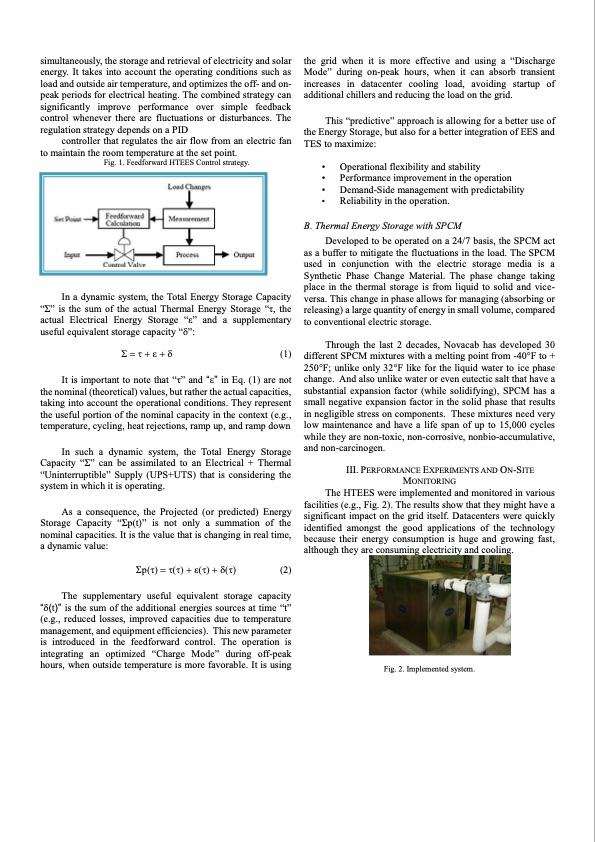
PDF Publication Title:
Text from PDF Page: 002
simultaneously, the storage and retrieval of electricity and solar energy. It takes into account the operating conditions such as load and outside air temperature, and optimizes the off- and on- peak periods for electrical heating. The combined strategy can significantly improve performance over simple feedback control whenever there are fluctuations or disturbances. The regulation strategy depends on a PID controller that regulates the air flow from an electric fan to maintain the room temperature at the set point. Fig. 1. Feedforward HTEES Control strategy. In a dynamic system, the Total Energy Storage Capacity “Σ” is the sum of the actual Thermal Energy Storage “τ, the actual Electrical Energy Storage “ε” and a supplementary useful equivalent storage capacity “”: It is important to note that “τ” and “” in Eq. (1) are not the nominal (theoretical) values, but rather the actual capacities, taking into account the operational conditions. They represent the useful portion of the nominal capacity in the context (e.g., temperature, cycling, heat rejections, ramp up, and ramp down In such a dynamic system, the Total Energy Storage Capacity “Σ” can be assimilated to an Electrical + Thermal “Uninterruptible” Supply (UPS+UTS) that is considering the system in which it is operating. As a consequence, the Projected (or predicted) Energy Storage Capacity “Σp(t)” is not only a summation of the nominal capacities. It is the value that is changing in real time, a dynamic value: p The supplementary useful equivalent storage capacity “(t)” is the sum of the additional energies sources at time “t” (e.g., reduced losses, improved capacities due to temperature management, and equipment efficiencies). This new parameter is introduced in the feedforward control. The operation is integrating an optimized “Charge Mode” during off-peak hours, when outside temperature is more favorable. It is using the grid when it is more effective and using a “Discharge Mode” during on-peak hours, when it can absorb transient increases in datacenter cooling load, avoiding startup of additional chillers and reducing the load on the grid. This “predictive” approach is allowing for a better use of the Energy Storage, but also for a better integration of EES and TES to maximize: • Operational flexibility and stability • Performance improvement in the operation • Demand-Side management with predictability • Reliability in the operation. B. Thermal Energy Storage with SPCM Developed to be operated on a 24/7 basis, the SPCM act as a buffer to mitigate the fluctuations in the load. The SPCM used in conjunction with the electric storage media is a Synthetic Phase Change Material. The phase change taking place in the thermal storage is from liquid to solid and vice- versa. This change in phase allows for managing (absorbing or releasing) a large quantity of energy in small volume, compared to conventional electric storage. Through the last 2 decades, Novacab has developed 30 different SPCM mixtures with a melting point from -40°F to + 250°F; unlike only 32°F like for the liquid water to ice phase change. And also unlike water or even eutectic salt that have a substantial expansion factor (while solidifying), SPCM has a small negative expansion factor in the solid phase that results in negligible stress on components. These mixtures need very low maintenance and have a life span of up to 15,000 cycles while they are non-toxic, non-corrosive, nonbio-accumulative, and non-carcinogen. III. PERFORMANCE EXPERIMENTS AND ON-SITE MONITORING The HTEES were implemented and monitored in various facilities (e.g., Fig. 2). The results show that they might have a significant impact on the grid itself. Datacenters were quickly identified amongst the good applications of the technology because their energy consumption is huge and growing fast, although they are consuming electricity and cooling. Fig. 2. Implemented system.PDF Image | Hybrid Thermal and Electric and Energy Storage System

PDF Search Title:
Hybrid Thermal and Electric and Energy Storage SystemOriginal File Name Searched:
2017_EESAT_Proceeding_Bilodeau.pdfDIY PDF Search: Google It | Yahoo | Bing
Turbine and System Plans CAD CAM: Special for this month, any plans are $10,000 for complete Cad/Cam blueprints. License is for one build. Try before you buy a production license. More Info
Waste Heat Power Technology: Organic Rankine Cycle uses waste heat to make electricity, shaft horsepower and cooling. More Info
All Turbine and System Products: Infinity Turbine ORD systems, turbine generator sets, build plans and more to use your waste heat from 30C to 100C. More Info
CO2 Phase Change Demonstrator: CO2 goes supercritical at 30 C. This is a experimental platform which you can use to demonstrate phase change with low heat. Includes integration area for small CO2 turbine, static generator, and more. This can also be used for a GTL Gas to Liquids experimental platform. More Info
Introducing the Infinity Turbine Products Infinity Turbine develops and builds systems for making power from waste heat. It also is working on innovative strategies for storing, making, and deploying energy. More Info
Need Strategy? Use our Consulting and analyst services Infinity Turbine LLC is pleased to announce its consulting and analyst services. We have worked in the renewable energy industry as a researcher, developing sales and markets, along with may inventions and innovations. More Info
Made in USA with Global Energy Millennial Web Engine These pages were made with the Global Energy Web PDF Engine using Filemaker (Claris) software.
Sand Battery Sand and Paraffin for TES Thermo Energy Storage More Info
| CONTACT TEL: 608-238-6001 Email: greg@infinityturbine.com | RSS | AMP |